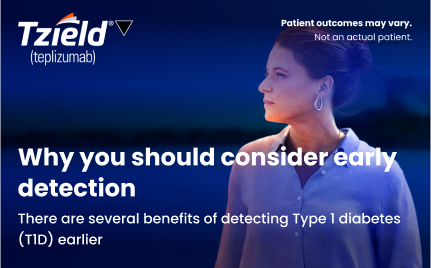Early detection can help avoid diabetic ketoacidosis (DKA) and misdiagnosis, and give your patients time to prepare
DKA
DKA is a medical emergency associated with high morbidity1
Prevalence of DKA at autoimmune T1D diagnosis is up to 70% across Europe and North America.1
DKA at diagnosis can have significant consequences, including:*2–6
Hospitalisation
Sustained negative effects
on glycaemic control over time
Neurocognitive impairments
Avoiding DKA at diagnosis is associated with better long-term glycaemic control.6,7 Early detection and monitoring of autoimmune T1D in children can:
Reduce rates of DKA by up to
85%†
preventing severe complications and reducing hospitalisation2,8
Facilitate prompt and effective glycaemic management9,10
Misdiagnosis
Autoantibody (AAb) testing can help to avoid a misdiagnosis of Type 2 diabetes (T2D) in adult patients with autoimmune T1D11
It can be difficult to distinguish between the initial symptoms of autoimmune T1D and symptoms of T2D; this often causes a misdiagnosis, particularly in adults.12
~40%
of adults with autoimmune T1D are initially misdiagnosed‡12
Of these, 77%
are misdiagnosed with T2D‡12
Misdiagnosis can delay timely insulin replacement therapy, resulting in prolonged hyperglycaemia and increased risk of DKA.12 Proactive AAb testing helps to determine whether abnormal glucose levels may be related to an autoimmune attack (T1D) or insulin resistance (T2D)11
Preparation time
Early detection offers preparation time and a smoother transition into life with symptomatic autoimmune T1D (Stage 3)2,13-16
Early detection of autoimmune T1D:
Creates a valuable window for proactive education and support2,13-16
Facilitates access to treatment for eligible patients with presymptomatic disease
(Stage 2)7,17
Offers the potential to delay progression to symptomatic disease (Stage 3)7,17
Children diagnosed with autoimmune T1D through screening had lower glycated haemoglobin (HbA1c) levels and fewer DKA events at Stage 3 vs the general population.§14
Get in Touch with Us
Questions? Leave your details and we'll reach out to you at your preferred time.
Get in touchINDICATION: TZIELD is indicated to delay the onset of Stage 3 T1D in adult and paediatric patients 8 years of age and older with Stage 2 T1D.17
*Independent of other variables.
†In a public health screening programme that screened 90,632 children aged 2 to 5 years for autoimmune T1D islet AAbs in Bavaria, Germany. Of the 62 children with presymptomatic autoimmune T1D who developed Stage 3 T1D, two (3.2%) were diagnosed in the laboratory with mild or moderate DKA without clinical symptoms, while 60 (96.8%) did not have DKA.8
‡In a retrospective online survey of people with autoimmune T1D and caregivers of people with autoimmune T1D in the United States (US), a diagnosis of autoimmune T1D was missed in 38.6% (n=330/856) of those diagnosed at ≥18 years of age. Of those people, 76.8% (n=253/330) were initially diagnosed with T2D.12
§These groups were not directly compared in the same study. Data from 128 children previously diagnosed with presymptomatic early-stage T1D between 2015 and 2022 in the Fr1da study were compared with data from 736 children diagnosed with incident T1D between 2009 and 2018 at a similar age in the DiMelli study without prior screening.14
AAb, autoantibody; DKA, diabetic ketoacidosis; HbA1c, glycated haemoglobin; T1D, Type 1 diabetes; T2D, Type 2 diabetes; US, United States.
- Wolfsdorf JI, et al. Pediatr Diabetes. 2018; 19(Suppl 27): 155–177.
- Besser REJ, et al. Arch Dis Child. 2022; 107(9): 790–795.
- Tomic D, et al. Diabet Med. 2024; 41(1): e15218.
- Cameron FJ, et al. Diabetes Care. 2014; 37(6): 1554–1562.
- Ghetti S, et al. Diabetes Care. 2020; 43(11): 2768–2775.
- Duca LM, et al. Diabetes Care. 2017; 40(9): 1249–1255.
- Sims EK, et al. Diabetes. 2022; 71: 610–623.
- Ziegler AG, et al. JAMA. 2020; 323(4): 339–351.
- DiMeglio LA, et al. Lancet. 2018; 391(10138): 2449–2462.
- Veijola R, et al. Pediatr Diabetes. 2016; 17(Suppl 22): 25–30.
- Diabetes UK – Autoantibody testing can help to diagnose diabetes type correctly. Available at: https://www.diabetes.org.uk/about-us/news-and-views/starting-right-diabetes-diagnosis. Accessed November 2025.
- Muñoz C, et al. Clin Diabetes. 2019; 37(3): 276–281.
- Narendran P. Diabetologia. 2019; 62(1): 24–27.
- Hummel S, et al. Diabetologia. 2023; 66(9): 1633–1642.
- Moore DJ, et al. Int J Gen Med. 2024; 17: 3003–3014.
- Quinn LM, et al. Br J Gen Pract. 2023; 73(726): 36–39.
- TZIELD® (teplizumab) UK Summary of Product Characteristics. 2025.
MAT-XU-2500760 (v1.0) | November 2025
